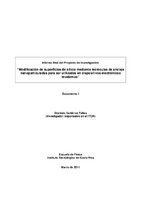Modificación de superficies de silicio mediante moléculas de anclaje nanoparticuladas para ser utilizadas en dispositivos electrónicos modernos
Date
2011Author
Montero-Villalobos, Mavis
Gutiérrez-Fallas, Dionisio
Vega-Baudrit, José
Urcuyo-Solórzano, Roberto
Sánchez-Zamora, Alejandra
González-Flores, Diego
Salazar-Morera, Norberto
Metadata
Show full item recordAbstract
Surface modification and attachment of molecules is one of the issues
nanotechnology has emerged in recent years. Mainly, it has been
noted its potential in the electronics industry. That is why, through the plan of strengthening education company Intel of Costa Rica, the investigation is power in this field in our country, with projections of the possibility that this technology replace technology Silicon was.
As a general objective the integration of nanoparticles was raised, known relevance in the field of electronics, in modified surfaces silicon, from anchor molecules.
Among the most important specific objectives was proposed: the study of
state of the art in synthesizing anchor molecules and the synthesis of
nanoparticles. Moreover, within the experimental activities, it was intended
obtain the synthesis of materials by the methods considered most
suitable. Another important objective was to achieve characterization
materials, mainly their structure, microstructure and electrical properties.
Two notable objectives were to foster a research relationship between the
INTEL and public universities in our country, in addition to promoting the
participation of students with the purpose of starting with the formation of a
generation of people with skills in the field of nanotechnology.
The methodology used in the project was running this in
three stages, each with a duration of a period of one year. In the first stage the study of the prior art, in addition to the preliminary synthesis of certain materials within these organic molecules and nanoparticles from a method of electrolysis was performed.
As a second step the optimization of the selected methods are planned and
anchoring the nanoparticle experimental study on silicon surfaces
previously selected.
In the third stage we continued with the synthesis of new molecular structures and particularly with the development of skills for the characterization of the materials at different stages.
This project is protected under intellectual rights
protection of the University of Costa Rica, however, my participation was
I associated with different stages, of which mention more results
major:
a) Developing skills in using various materials characterization
techniques associated with XRD (powder diffraction, reflectance).
b) Participation in the process of training students on issues related to
crystallography, by working on two graduate courses in Chemistry
the University of Costa Rica.
c) Participation as tutor thesis and graduation projects associated with
investigation project.
d) Collaboration in presenting papers at national conferences.
As an important conclusion about my participation in the project, it highlights the
experience developed in the interpretation of some related to the synthesis and characterization of nanometer materials, mainly in the X-ray diffraction and electrical characterization of materials scale phenomena. With regard specifically to the research results, a gap in which, for the first time, the company Intel strengthened the training of a generation of professionals in our country, where research forms a major part of their started skills.
Description
Proyecto de Investigación. Instituto Tecnológico de Costa Rica. Escuela de Física; Escuela de Ciencia e Ingeniería de los Materiales; Universidad de Costa Rica. Escuela de Química; Laboratorio Nacional de Nanotecnología LANOTEC-CENAT, 2011


